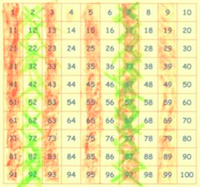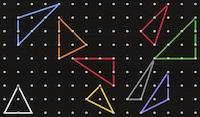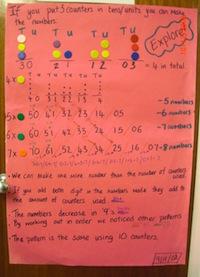Using NRICH Solutions as a Resource
On the NRICH site, we publish learners' own solutions to our tasks, which often reflect different approaches to an activity. At any time, our Primary Live Problems are open for children to send in solutions to, and then the following half term, we publish a selection of the solutions we receive as recently solved tasks. (If you would
like to know more about what we look out for when we decide which solutions to include, please take a look at here.) In this article, which is part of our Using NRICH Solutions Feature, we suggest ways in which children's solutions on the NRICH site can be used as a teaching resource in their own right.
Introduction
As well as being a source of rich mathematical tasks, NRICH also publishes rich solutions to these tasks, submitted by children from all over the world. These learners' solutions are a useful resource in themselves and are perhaps under-valued. In this article, we outline some possible ways in which NRICH solutions could be used to support the teaching and learning of mathematics, and
make reference to particular NRICH tasks and their accompanying children's solutions.
As a broad categorisation, we find it helpful to consider who might directly use the solutions which are published on NRICH. Is it the teacher, or is it the children themselves, facilitated by the teacher? Let's look at these two options in turn.
Teachers' use of the published solutions
As a teacher, you might look at the published solutions to a particular task before having a go at it with the class. You might do this to check the answer/s but it will also help you get a sense of the variety of responses which your learners might produce. The solutions on the site might reveal ways of approaching the task that you had not thought of yourself, although of course
your own children may find other ways still.
An additional way to use NRICH solutions as a teacher might be during a staff meeting to facilitate conversations about assessment. You could give colleagues the chance to work on an NRICH task briefly themselves, then share examples of children's work published on the site. Initially, encourage a positive frame of mind and ask:
- What does each solution show that the learner knows?
- What understandings have been demonstrated?
Follow that up with:
- What might each child need to work on?
(There is a caveat here in that we are taking the written solution in isolation, which might be a bit artificial. In the classroom, formative assessment would be based on conversations with the children as well as any jottings or other recordings they made before writing up a 'final' solution.) It could be that you then encourage colleagues to have a go at the task with their own
classes, where appropriate, and come back together at a later date to discuss experiences.![]()
Lower primary: Heads and Feet and Robot Monsters
Upper primary: Coded Hundred Square and Make 37
Children's use of the published solutions
There are a number of different ways in which you, as the teacher, might facilitate the use of NRICH solutions by children during a lesson.
1. Analysing others' reasoning
![]()
Lower primary: Sizing Them Up, Number Round Up and Lots of Lollies
Upper primary: Trebling, Forgot the Numbers and Fitted
To find out more about this particular approach to using children's work, see Malcolm Swan's article, Improving Reasoning: Analysing Alternative Approaches, which outlines how placing reasoning as the focus of pupils' attention and analysing it in this way improves learners' own mathematical reasoning.
2. Spotting the 'slip-up'
Inside Triangles (a lower primary task) - Greg has found seven solutions, but then 'Swifts Class' asserts there are nine. Has Greg missed out two? If so, can learners draw them? You could then share the solution from Millbrook School to see whether your class agrees with Lily-Mai and Dillon.![]()
Reflecting Squarely (this task is in fact labelled as a lower secondary task, but could be used with children towards the end of primary school and with younger children if fewer pieces were used) - Andrei has used a very systematic approach to find all the solutions in this task, but Sara points out that he has missed out just one. Can learners in your class find
it without looking at Sara's work?
3. Appreciating different approaches
- Which was like yours?
- Find something you like in one of the others. Why do you like it?
- Which solution do you think is most elegant? Why?
- If you were given another task like this in the future, would you change the way you solved it? Why or why not?
This way of using NRICH solutions very much places the focus on the method rather than the answer and it might 'force' some children out of their comfort zones, which is when learning takes place. It emphasises the idea that there is not simply one 'right' way to approach a task and validates approaches other than the child's own. It could be likened to comparing different routes
between two places on a map, one of which might be more scenic, another of which might be quicker, for example. By examining other children's solutions in this way, learners are encouraged to continue to think and question, rather than sitting back when an answer is reached. It may also give some children more confidence to try things out when problem solving in the future. Even
if you as the teacher have struggled to unpick a method used in a published solution, don't let that put you off sharing it with your class. Admitting to your class that you have not fully followed this approach will create a sense of everyone working together to understand the solution, which can be very motivating.![]()
Lower primary: Eggs in Baskets, Two Dice and 6 Beads
Upper primary: 4 Dom, Maze 100, Light the Lights Again and Match the Matches
In conclusion
We hope that you will be inspired to incorporate NRICH's published solutions into your mathematics lessons and to see the benefits. If you have further ideas for ways in which NRICH solutions can be used, please do let us know - we would love to hear from you.
Here is a PDF version of this article.
